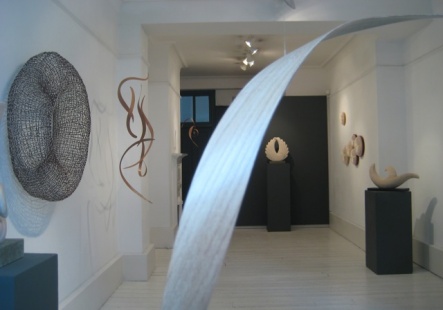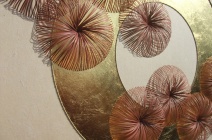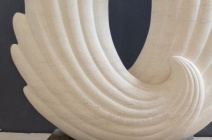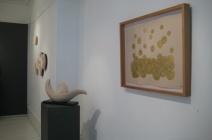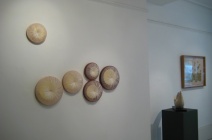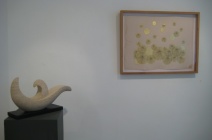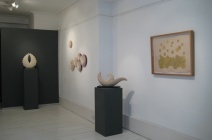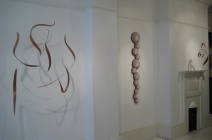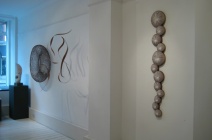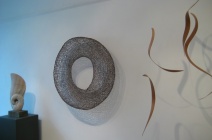Earth, Wind and Stone
Earth, Wind and Stone
Juliet and Jamie Gutch - Kazuhito Takadoi - Jude Tucker
The remembrance of a warm and gentle summer is brought into jaggedart in the works of this exhibition. Earth Wind and Stone includes work by gallery artists who inherently understand how to extort the most from their respective materials. Each artist represents an element, which, in spite of their permanent and stationary essence, is imbued with movement and flux. Juliet and Jamie Gutch’s mobiles move through the air as a constantly unfurling, unfolding Mobius sculpture. Jude Tucker’s stone sculptures, though evidently stationary, are comprised of fluid lines and forms hewn from the stone, which move the viewer towards and around the work. Kazuhito Takadoi’s interest in shadows is an important dimension to his grass, wood and twig sculptures, “As the light changes or the point of view is moved, so the shadows will create a new perspective.”
Juliet and Jamie Gutch’s mobiles are created from different undulating leaves of wood or painted metal, often centred around a smooth and certain stone. The different elements of each sculpture are in perfect balance, they glance past each other, suggesting an intention to touch, but never doing so.
Juliet and Jamie’s work is about balance: “It is based on three areas of exploration. The first is the finding of a point of balance which, when found, reveals itself to be both miniscule but at the same time unbelievably strong in that the whole work rests upon it. The second is the way a mobile freely explores space within the limitations of its form and its environment. The third is that each element of a mobile is necessary in order to maintain the integrity of the whole and therefore equally valued. Through our work we want people to wonder about balance and to experience what happens when balance is lost, not found or restricted in some way. We want people to understand the sculptural language of mobiles and its relevance today.”
The six mobiles in the series 'Desire Lines' are inspired by and respond to the harmonious lines in Bellini's San Zaccaria altarpiece in Venice, described by John Ruskin as 'having every quality in balance'. Juliet and Jamie draw comparison to the lines of desire which are direct and inimitable, to the compositional lines of Bellini’s masterpiece, which led to the profound sense of balance and harmony experienced by Ruskin. The style of painting is known as a 'Sacra Conversazione' and in this series each mobile is made up of two elements which are 'in conversation' with each other as they move around each other. Made from elm wood with its beautiful grain and characteristic strength and lightness, the mobiles interact gracefully in response to natural air currents in ever-changing compositions.
Juliet and Jamie both studied languages, at Birmingham University and Cambridge University, respectively, developing their artistic style and direction independently, before meeting in 2001. Juliet and Jamie were commissioned to create an ambitious 12-metre mobile in the £35m John Lewis at Stratford for the 2012 London Olympics, which was inspired by larks flying across East End marshes.
Kazuhito Takadoi’s work is deeply involved with nature, through both the medium and his subject, and represents the element Earth in this exhibition. Working with grasses and twigs, as well as gold leaf which also comes from the ground, Kazuhito creates exquisite works are full of dichotomies. His work is both minimal, yet opulent. It is simultaneously fragile yet has strength, and combines the formality of Eastern discipline with abstraction from Western art. Inspired by the rich woodland surrounding his birthplace of Nagoya, Japan, Kazuhito grows and hand picks grasses, leaves and twigs from his garden, sowing each blade through the paper. As the grasses dry and mature they embark on a subtle colour shift, comparative to seasonal change.
Kazuhito has also developed the embroidery process to include pure white Japanese book binding threads as a material. The flexibility and rigidity of these fibres give an even greater sense of three dimensionality to his work. Kazuhito uses a range of wood including Cedar of Lebanon, Oak, Elm and Walnut. The titles of his works allude further to the natural world, not only to the woodlands and materials he uses, but also to the weather and the cosmos. Apparently abstract, each piece has a story behind it.
Kazuhito trained in Agriculture and Horticulture in Japan the US and in the UK, before studying Art and Garden Design.
Jude Tucker's graceful sculptures and carvings in stone depict a series of flowers, trees and seeds. The ephemeral delicacy of her subject is underlined by its translation into an immutable form. Time is halted - a moment preserved - in the sensitively rendered works.
Jude is inspired by the natural world and is conscious of the strong, yet at times, subtle links between us and natural life forms. Her work is joyful and beautiful, and celebrates strength and feminine sensuality. Often working with single blocks of stone, Jude emphasises the translucency in alabaster or the natural fragments of partially fossilised shells which are flecked through the body of the sculpture. Jude’s understanding of form and the different types of stone she uses, as well as to engage intimately in the creative dialogue, is partly a result of a conscious decision to avoid the over use of machines and to carve as much as possible with hand tools. Jude exhibits a masterful control and skill with the stone, which is hand cut, carved and finished. The tactile quality of the sculptures draws the viewer to these sensuous objects depicting natural forms and alabaster curves. Using a variety of different stones, Jude's intricate works celebrate natural beauty and form.
Jude Tucker trained at City and Guilds in stone carving. She is the first woman to have been commissioned to carve grotesques for St George’s Chapel in Windsor. Jude was awarded the Bernard Noble Sculpture Prize in 2011 and has been showing in jaggedart since 2007.

